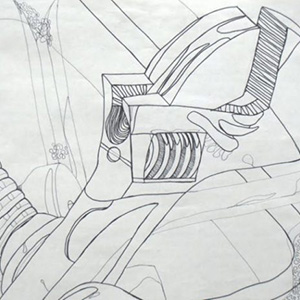
Learning Objectives
- Develop observational, compositional and conceptual problem-solving skills
- Demonstrate proficiency in the use of basic drawing media
- Demonstrate various drawing techniques
- Demonstrate the ability to critically assess works of visual art
- Demonstrate appropriate methods of presenting their finished work
- Demonstrate excellent time management and work ethic
Project Description
Students will start with a gesture drawing to refresh what they learned from the previous class. I will go over the difference between a gesture (quick, mass, movement) and a contour (detail, slow, focused). Students will complete several contour drawings of their hands in various positions as well as a few blind contours to demonstrate the idea of hand eye coordination.
For the major portion of the project you will be completing 2 contour drawings in sharpie on white paper.
Project Considerations
Unlike a gesture drawing’s quick and intuitive process, contour drawings are slow and methodical. Contour drawings reinforce our hand eye coordination, much like playing video games.
Contour drawings can be frustrating because they are painstakingly slow, but the goal is to force us to slow down and really look at the objects we are drawing. Too often we draw the idea of a tree or the idea of a chair instead of the tree or chair that is in front of us. Contour drawings force us to focus on the specifics of the object in front of us.
A couple of tips – Take your time and enjoy the process. It is ok if you mess up; this assignment is about training out hands to coordinate with our eyes and it is hard. The more you practice, the better you will get.
Materials
- Sketchbook
- 2 sheets of 18” x 24” White Drawing Paper
- Dual Fine and Ultra Fine Tip Sharpie Marker
- Pencil
- Still life objects
Directions
1. 5 gesture drawings of your chosen objects in your sketchbook (make sure to use a view finder so you can focus on good composition). You need at least 5 different compositions. You may need more depending on the composition.
2. 5 contour drawings of your hands and / or feet in your sketchbook.
For this assignment, you need to create 2 contour drawings. Using at least 5 still life objects, create 8 different compositions and sketch these compositions in your sketchbook. I will help you select the 3 best compositions. Remember to think about where your eyes are moving through the image. Are you stuck in the center, or are you creating enough focal points to allow the viewer to find interest throughout your drawing without creating the “kudzu” effect?
Once you have your good compositions selected, reset up your tool still life for each one. Gesture the tools onto your large sheets of paper with a pencil, paying close attention to composition and technical accuracy. Once these are gestured out you can start with contour drawings. DO NOT TRACE YOUR GESTURE. DRAW FROM THE STILL LIFE; USE YOUR GESTURE ONLY AS A REFERENCE. Create this drawing using a fine tipped Sharpie marker. The drawing created on watercolor paper will be used for a value study assignment later in the semester. The drawing on watercolor paper should be the best out of the three.
Remember…do not lift your pen when you start your contour. Your eyes, along with your pen should visually trace the object. It’s ok if you get out of proportion. The goal of this assignment is to train yourself to focus on the details. If you choose a hammer, draw THAT hammer, not your understanding or mental image of a hammer. Draw that specific hammer with all its flaws and distinct characteristics.
Examples / Research:

















































